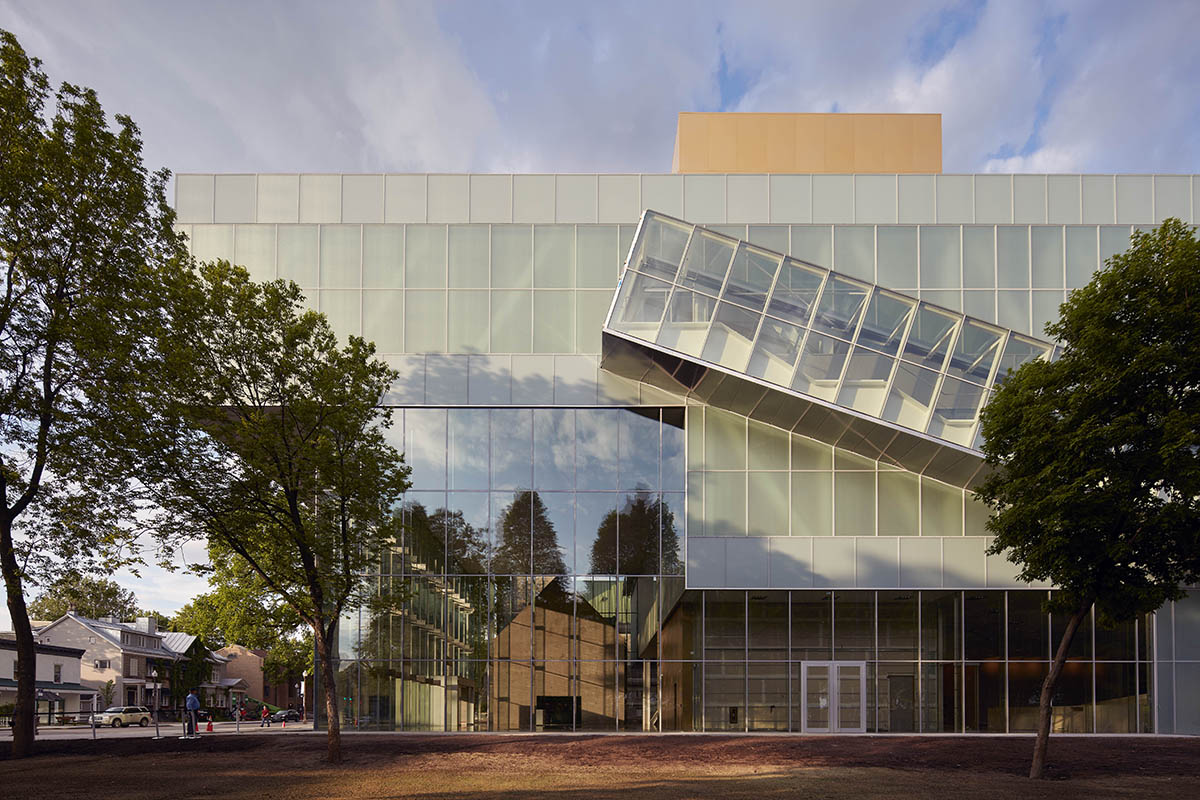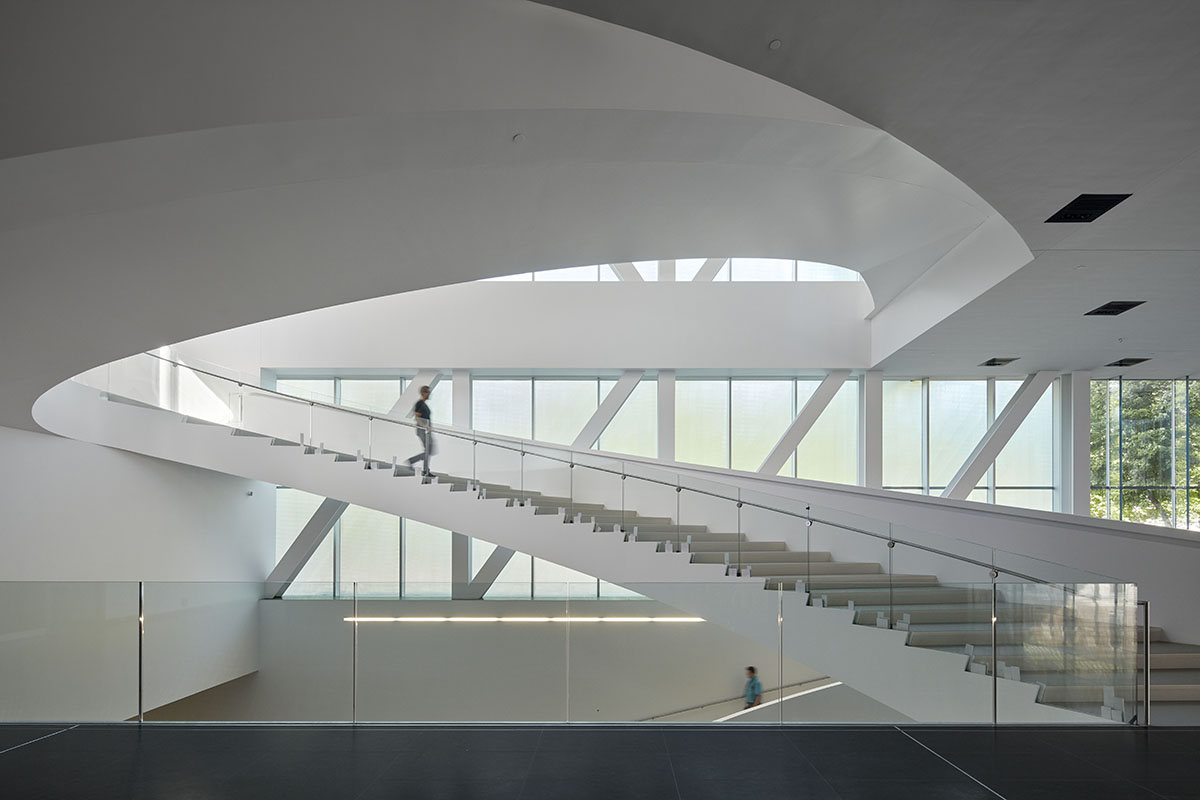Submitted by WA Contents
The Pierre Lassonde Pavilion by OMA Opens its Doors Today on the Grande Allée
Canada Architecture News - Jun 24, 2016 - 15:17 13991 views

OMA's design the Pierre Lassonde pavilion, the fourth building of the Musée national des beaux-arts du Québec (MNBAQ), opens its doors today in Québec, Canada, the design led by OMA New York Partner, Sho Shigematsu. The largest cultural project in Québec, the Pierre Lassonde pavilion is opening its doors on the Grande Allée in Québec City.
Resolutely turned towards the future, the new world-class building, the fourth pavilion in the museum complex, designed by the architectural consortium OMA of New York and Provencher_Roy or Montréal, will transform the venerable eighty-three-year-old institution by bringing together like never before urban life in Québec City and the picturesque landscape of National Battlefields Park.
The new building, 14,900 square metres in surface area, enables the MNBAQ to double its exhibition space and will serve as a light-filled and contemporary gateway to the museum complex, which previously included three pavilions, in addition to providing it with larger spaces for presenting its collections and letting the art and artists from here and abroad shine.

The MNBAQ, whose mission consists in promoting and preserving Québec art since the seventeenth century and in presenting exhibitions of international art in Québec City, is inaugurating its new pavilion with seven new exhibitions featuring its major collection of contemporary and present-day art from 1960 to today, including Inuit art and the decorative arts and design.
To mark this opening in an exceptional manner, it made perfect sense to have it coincide with Québec’s Fête nationale and to offer three days of festivities and free public activities.

''We are delighted to be able to welcome the public in this immense space, brilliantly designed by OMA, which will contribute greatly to giving visibility to Québec art and artists. Thanks to this magnificently functional addition, one that is also significant on a symbolic level, our Musée has now reached an unrivalled level of service for the citizens of Québec and is a major attraction for visitors from around the world'' said Pierre Lassonde, chairperson of the MNBAQ’s board of directors.

''The world heritage site that is Québec City has just added a new emblem,'' remarked Line Ouellet, executive director and chief curator of the institution. ''Refined and ingenious, the Pierre Lassonde pavilion succeeds not only in standing out on the architectural level, but especially in becoming a part of its surroundings by making the most of its urban location with a logic that is both implacable and unexpected. Thanks to its spacious exhibition galleries, auditorium, restaurant, bookstore-gift shop and other facilities, it will enable the MNBAQ to fully realize its potential''

''The concept places three volumes on top of one another in such a way that they form a cascade that extends the topography of the park. Urban activity penetrates its highest level, becoming a new point of contact between the city and the park,'' explained Shohei Shigematsu, OMA associate and director of its New York office, in charge of the project. ''Art becomes a catalyst, letting the visitor experience everything, the three essential elements, at once: the park, the city and the Musée''

Created in collaboration with Provencher_Roy of Montréal, the Pierre Lassonde pavilion faces the Grande Allée, a prestigious traffic artery in Québec City. Behind the new pavilion, the Musée’s three existing buildings – the pavilion of historical art dating from 1933, the modern art pavilion, a former prison built in 1867, and finally the central pavilion, created in 1991 – rise up in the park. The Pierre Lassonde pavilion is connected to the rest of the museum complex by an underground corridor 130 metres in length.

The Riopelle Passageway by CGI is made up of three custom-made galleries to house Jean-Paul Riopelle’s triptych Tribute to Rosa Luxemburg. It includes a curved section which echoes the traffic roundabout at the intersection of Wolfe-Montcalm and George VI avenues and gives a lively twist to the passageway.
Among the spectacular elements of the Pierre Lassonde pavilion, the curtain wall of the main lobby boasts an impressive façade 26.5 metres wide and 12.5 metres tall, sheltered under an imposing cantilevered roof. Glass panels installed perpendicularly at regular intervals, provide a vertical motif to the impressive frontage. This majestic space serves as an interface with the Grande Allée and urban space for the Musée’s public activities. The façade is at once structural, thermal and solar, to meet the seemingly contradictory needs of natural light and thermal insulation imposed by the rigours of the Québec winter.

The lower part of the main lobby, seven metres in height, opens onto four temporary exhibition galleries as well as the inner courtyard, the bookstore-gift shop and the monumental staircase leading to the new auditorium.
The concrete wall in the main lobby, forming the new southwest gable of the presbytery, is another unique architectural element in Québec. It was cast in a single block using formwork built very meticulously horizontally and then raised to a vertical position with a crane.

The monumental staircase rises up three storeys to the heart of the building with a dizzying spiral of three flights made out of four sections of steel. A curved glass balustrade provides all those who take this majestic staircase with a memorable experience.
The Canam Group suspended staircase, connecting the second and third floors, protrudes from the building and offers a view of the park that will take visitors’ breath away and give them the impression of walking between heaven and earth.

The inner courtyard, 500 square metres in size, joins the heritage aspect of the Saint-Dominique presbytery and church – in an English Neo-gothic style – with the new building’s contemporary lines of glass and steel.
This partially-covered public space is home to a work by Ludovic Boney, Une Cosmologie sans genèse (A Cosmology without Genesis), created following a public art competition organized by the Ministère de la Culture et des Communications in collaboration with the MNBAQ. The rounded forms of the light grey granite echo one of the elements of Boney’s monumental artwork, an immense sphere made up of 800 aluminum cones.

On the third level, on the south side, a terrace with a capacity of 60 people is the site of a bronze sculpture by Patrick Coutu, Le jardin du sculpteur (The Sculptor’s Garden), created thanks to a contribution by the Monique and Robert Parizeau Foundation.
The perspective afforded by the terrace lets visitors not only admire the landscape and enjoy the stunning view of the three other pavilions in the museum complex and the St. Lawrence River, but also appreciate the beauty of the green roofs, where 90,000 plants grow. Five kinds of hardy succulent plants create a motif which reproduces the site’s topographical lines.

Glass truly envelopes the whole building. Three kinds of glass panels – transparent, translucent and opaque – where meticulously chosen by the architects to play with this impression of inside out, but also to meet the needs of an creating an energy-efficient building that adheres to the principles of sustainable development using thermally-treated anti-UV glass.

The architects chose to texture some of the translucent and opaque glass panels. Motifs in the form of points were silkscreened onto them, creating a refined optical effect, following the elements of the building’s imposing steel structure. The insulated walls of the exhibition galleries alternate with the translucent windows, making the building light up at night like a lantern in the park.

A visit to the pavilion is punctuated by light-filled spaces adjacent to the exhibition galleries. Like the circulation spaces, the exhibition galleries have openings which enable visitors to maintain visual contact with the park, the city and the other buildings in the museum complex during their visit.
These perspectives allow natural light to enter, something very rare in an art museum, making visitors’ experience more dynamic and enabling them to remain in constant dialogue with the outdoor environment.

In the main lobby of the Pierre Lassonde pavilion is also found Tempéra Québecor signé Marie-Chantal Lepage. From this exceptional glass jewel case the new culinary menu, designed by the Musée’s resident chef, focuses on sharing for its festive and welcoming spirit. The 256-seat Sandra and Alain Bouchard auditorium can host a wide range of cultural events (lectures, films, dance, theatre, etc.).
A bookstore-gift shop, designed by the architect Shohei Shigematsu on two floors with curved wall and warm blonde pine, offers a selection of art books as well as unique objects created by Québec artists, in addition to offering a reading space – the Dupont Foundation – with a view of the inner courtyard.
The Pierre Lassonde pavilion is the result of the first-ever international architectural competition in Québec City and will become the nerve centre of the brand new Arts District. It will bring to the world’s attention not only this district and the city but also the province and the entire country.
All images © Bruce Damonte
> via MNBAQ
